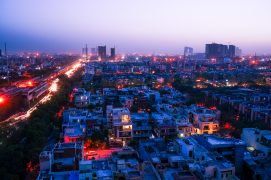The Age Of The City…Rural Migration Has Reshaped India’s Real Estate Markets
They called it Cottonopolis: in 1815 Manchester had a population of just 45,000, and the soon to be City had no Parliamentary representation at all: unlike the constituency of Old Sarum near Salisbury, which had two MPs and a population of precisely one…the voter (a shepherd) died in 1821, and without the inconvenience of having anyone to represent, Old Sarum carried on sending MPs to Parliament for another eleven years. Manchester, on the other hand, was doubling in size every ten years, and by 1850 it was the second biggest City in Britain, with a population of 400,000. The explosive social and economic impact of the Industrial Revolution had caused a seismic demographic shift, draining the countryside of labourers and drawing them to the Mills like a magnet…it was the Age of the City.
Of course, there’s nothing new under the Sun: we can still see this trend at play in modern day India, and it’s having a profound effect on Real Estate markets too.
The Subcontinent’s most recent Census (taken in 2011) reported an astonishing 51% increase in rural to urban migration: 78 Million people moved into India’s burgeoning cosmopolitan centres in less than a decade. The population of Mumbai grew from 16,147,000 to 18,464,000 between 2001 and 2011, and today it stands at 20,668,000 (more than twice the size of London, with year on year growth of 1.26%). Bangalore is an equally striking example: growing by 4% every year since 2011, from 8,636,000 to 12,765,000. All those computers in Bangalore’s backstreets seem to have had a magnetic effect of their own…
You don’t need to spend long on Google to work out why India’s hinterland is emptying out just as dramatically as the fields around Manchester were two hundred years ago.
Inequality of Resources
Even the most wooden headed economics undergraduate can tell you mass migration is invariably a consequence of inequality in distribution of resources, and the key driver for comparative inequality is economic expansion: increasing industrialisation and infrastructure development is almost invariably centered on the City, driving up urban living standards and creating an ever widening divide with (comparatively) poorer rural areas. So to understand why India’s rural poor have been voting with their feet for the last forty years, you only need to read recent reports of social and economic unrest among the subcontinent’s previously all-important farming community…since the Indian Government introduced its landmark Liberalisation, Privatisation and Globalisation (or LPG for short) Policy in 1991 (www.papertyari.com), they’ve been moving to the City in their droves. Agriculture has been a politically cherished cornerstone of the modern Indian State since 1947 (and before), but LPG made its eventual dislocation inevitable.
Cities grew richer as India became the fastest growing large economy on the planet; economic expansion encouraged a progressive displacement between urban and rural inequalities, and the urban poor have migrated to seek out new opportunities as a result.
It’s as simple (and as complicated) as that.
The Challenge of Urbanisation
But all those rural migrants need somewhere to live when they get to the City, and impoverished living conditions are an increasing cause for concern across India’s heavily built up conurbations, which is why Prime Minister Modi’s reinvigorated Affordable Housing Programme (www.realty.economictimes.indiatimes.com) is proving to be such an important part of India’s future: building more homes, faster and more efficiently than ever before.
In the Age of the City, the City has to make sense: it has to meet everyone’s needs.
Executive Overview
Increased levels of urbanisation in India (and elsewhere) are both an opportunity and a challenge: we have to learn to build homes better, faster and smarter, which is why Modular Construction is becoming so important: It will be a key part of addressing homelessness across the globe.



